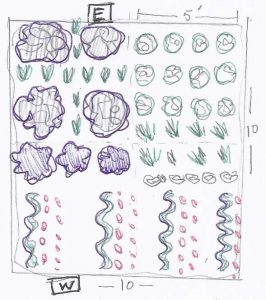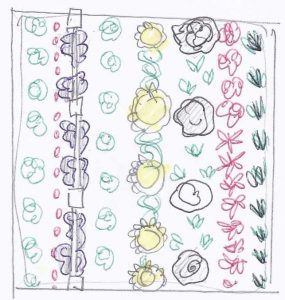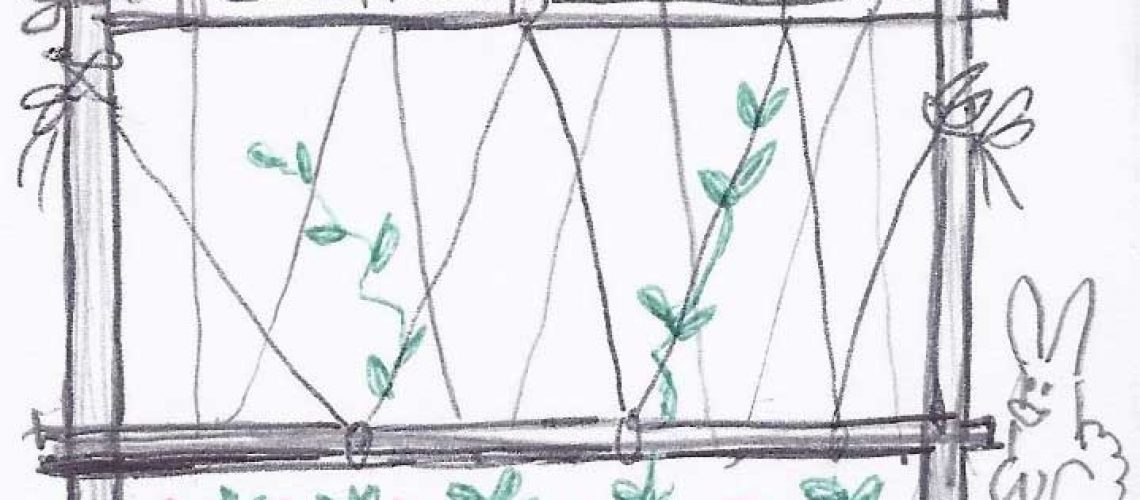We want you to be successful and satisfied with your efforts in the garden. Before you buy, it really helps to start with a plan.
 Sketch your plot using a ruler. It doesn’t have to be fancy. Note where the sun will rise and set. Trellises are great in small spaces, aligned with the sun so they don’t create shade.
Sketch your plot using a ruler. It doesn’t have to be fancy. Note where the sun will rise and set. Trellises are great in small spaces, aligned with the sun so they don’t create shade.
Give larger plants (tomatoes, okra, eggplant, etc.) at least 3-4’ each. While they’re growing, there will be unused but temporary space, perfect for fast growing short plants that you won’t need all season, (lettuce, early greens).
The wiggly lines are trellises for peas or beans, cucumbers, anything that can climb upwards.
Pole Beans need at least a foot of room between plants. At their feet, you can grow radishes or beets (6-8”) until the plants get taller. Bush beans take about the same, maybe even a bit more room. Cucumbers more like 3-4’ each.
Seriously, do not overplant. Pace yourself.
 In the second sample, plants are in rows to keep infestations down and allow for walking. In a 10’ plot, there will be space for maybe 4 large plants and some smaller ones.
In the second sample, plants are in rows to keep infestations down and allow for walking. In a 10’ plot, there will be space for maybe 4 large plants and some smaller ones.
We put a trellis on the left of this design to add space. Onions are on the outside, flowers next to them to keep the oils from affecting other plants. Sunflowers and other large plants can have smaller greens near until they are crowded out.
Building simple but strong frames will give you more space to work and allow you to harvest your produce much more easily.

Before you purchase plants, plot your plot.
Once at the store, read labels. Whether seed or growing pots, it should have descriptions of the conditions the plant prefers. It’s easy to be distracted by pretty flowers and thoughts of delicious produce, but not everything does well in Virginia Beach.
Only one of these seed packets will work at the Garden. The moonflower blooms at night…when no one is there to see it!
Some gardeners plan for multiple harvests and repeat plantings. There are plenty of websites devoted to organic gardening practices and advice.
Size, conditions, preference, and one final test:
Pests
The Garden has been used for a few years now. Last year, it was noted that squash borers are ruining anything in the squash family. Since this is an organic garden, there is only so much we can do to prevent problems. We are asking folks to not plant anything in the squash family (pumpkins, zucchini, squash) for 3 years to rid the soil of the dormant pests.
Since this is an organic garden, we respectfully ask that you refrain from using commercially prepared fertilizers and pesticides. You may use organic mixtures or you can ask for help and we will spray when possible with Neem Oil.
Be aware that come summer, the garden will have bees, wasps, moths, butterflies, birds, and bats. They come with the territory. Please familiarize yourselves with Cicada Killers, Red Velvet Ants, Honey Bees, and Miner Bees. Two of these do not sting. If you have allergies, you should be prepared.
Weeding
Plan on 3 major weeding sessions for the season, two in Spring, one in Summer, and at least 2-4 hours a week of just puttering. If you tackle weeds before they go to seed, you won’t be as frustrated. Use bagged grass or leaf clippings to mulch after you are finished to keep weeds from starting again. Weed in the morning or evening if you can, especially after rain. Training tomatoes to a trellis like a farmer.
Lastly, be respectful of your neighbors when using the water spigots and don’t trample their plants.
Bring friends, bring family, bring picnics. Enjoy!

